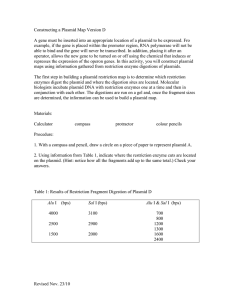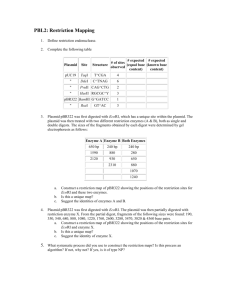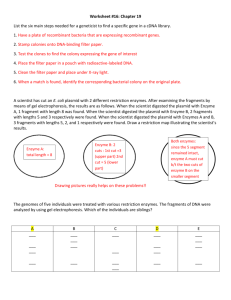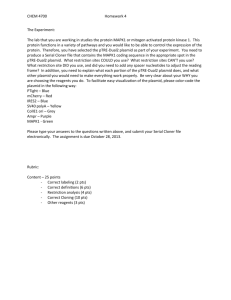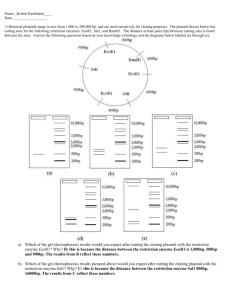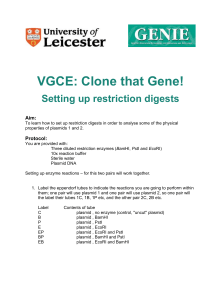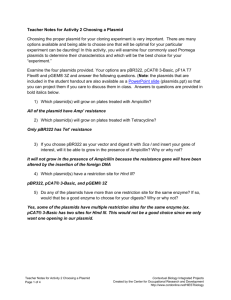LABORATORY REPORT GUIDELINES
advertisement
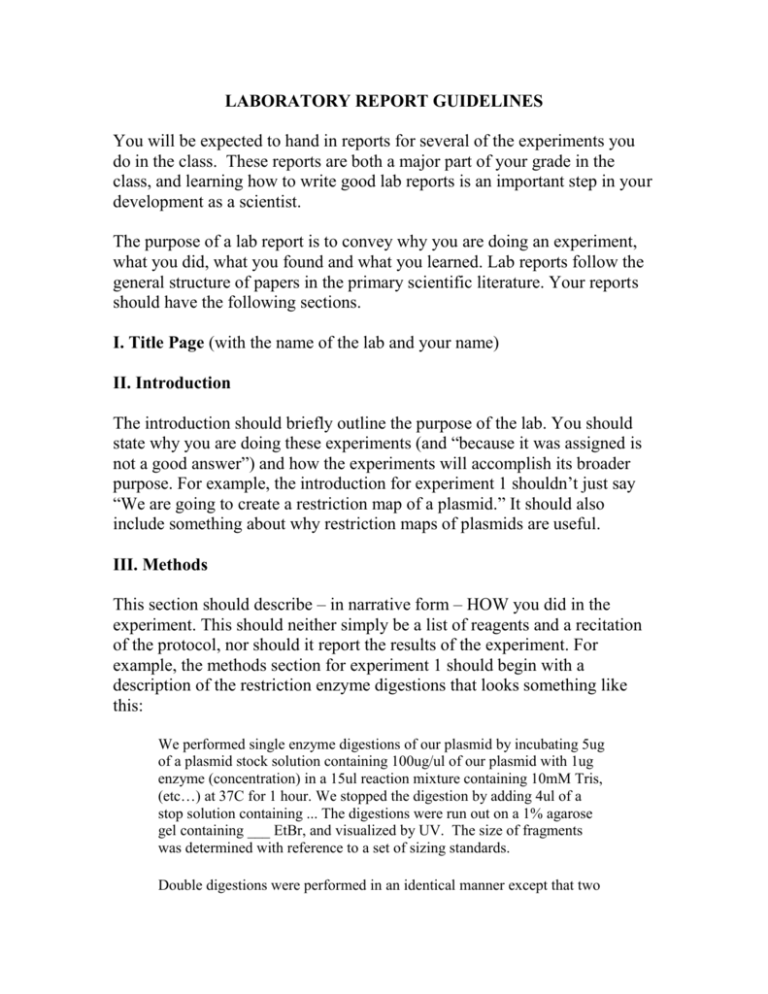
LABORATORY REPORT GUIDELINES You will be expected to hand in reports for several of the experiments you do in the class. These reports are both a major part of your grade in the class, and learning how to write good lab reports is an important step in your development as a scientist. The purpose of a lab report is to convey why you are doing an experiment, what you did, what you found and what you learned. Lab reports follow the general structure of papers in the primary scientific literature. Your reports should have the following sections. I. Title Page (with the name of the lab and your name) II. Introduction The introduction should briefly outline the purpose of the lab. You should state why you are doing these experiments (and “because it was assigned is not a good answer”) and how the experiments will accomplish its broader purpose. For example, the introduction for experiment 1 shouldn’t just say “We are going to create a restriction map of a plasmid.” It should also include something about why restriction maps of plasmids are useful. III. Methods This section should describe – in narrative form – HOW you did in the experiment. This should neither simply be a list of reagents and a recitation of the protocol, nor should it report the results of the experiment. For example, the methods section for experiment 1 should begin with a description of the restriction enzyme digestions that looks something like this: We performed single enzyme digestions of our plasmid by incubating 5ug of a plasmid stock solution containing 100ug/ul of our plasmid with 1ug enzyme (concentration) in a 15ul reaction mixture containing 10mM Tris, (etc…) at 37C for 1 hour. We stopped the digestion by adding 4ul of a stop solution containing ... The digestions were run out on a 1% agarose gel containing ___ EtBr, and visualized by UV. The size of fragments was determined with reference to a set of sizing standards. Double digestions were performed in an identical manner except that two enzymes were added… NOTE: The important thing here is what was in the reaction, and how you treated it. It’s not important to say that you added the water before the buffer. IV. Results This is the most important section! It contains all of your data and resulting facts. It should also be in narrative form, and include figures and tables wherever appropriate. No data in any form should be presented in other sections. For example, the report for experiment 1 might begin: To create a restriction map of our plasmid, we initially performed single digestions using the enzymes BamHI, EcoRI, HindIII, PstI, ScaI, XbaI, and XhoI. The results are shown in Figure 1 and summarized in Table 1. Figure 1. Single Enzyme Restriction Digest of Plasmid. 1% agarose gel showing the results of digestion of plasmid X with seven restriction enzymes (see Methods). Enzyme Number of Sites BamHI EcoRI HindIII PstI ScaI XbaI XhoI 1 2 0 1 3 2 1 Fragment Sizes (basepairs) 4500 2000, 2500 4500 3000,1000,500 3000,1500 4500 Table 1. Results of Single Enzyme Restriction Digest. Based on the results of these single digestions, we performed double digests with all pairs of enzymes that cut the plasmid at least once… Some general guidelines: In most cases you should include both raw and processed data. For example, include both a picture of your gel AND a table summarizing the results. The exception is if there is too much raw data to place in the report, or if it is in a form that makes this impossible. Figures are used to present images, graphs, diagrams or other graphical objects. Tables are used exclusively to present lists of numbers or other data in rows and columns. All figures and tables must be referred to in the text, fully labeled, and have a legend describing the information they contain. In general, analysis of results should be in the Discussion section. However, this is not a hard and fast rule. It is sometimes necessary to perform certain analyses before proceeding to the next part of an experiment, and in such cases these analyses should V. Discussion/Conclusions This is where you summarize what you learned from the experiment and any observations about your data you wish to make. For some of the experiments we are doing, the discussion section will be fairly short since the results are self-explanatory. Other experiments require more extensive discussion. You should not be presenting new data here, nor should you be restating the data. You should be discussing it. Again, the line between Results and Discussion is sometimes blurry. For example, in experiment 1 you might be tempted to put your final restriction map in the Discussion section, since it represents the analysis of data, not data itself. However, I would put this in the results since it is really a fact produced by your experiment.
